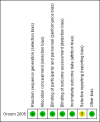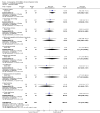Cyclo-oxygenase (COX) inhibitors for preventing preterm labour
- PMID: 23076936
- PMCID: PMC11403559
- DOI: 10.1002/14651858.CD007748.pub2
Cyclo-oxygenase (COX) inhibitors for preventing preterm labour
Abstract
Background: Preventing preterm labour is the most important step in preventing preterm birth. Prostaglandins play an important role in labour and birth. Prostaglandin production can be obstructed by inhibition of the cyclo-oxygenase (COX) enzyme and this may arrest uterine contraction. A Cochrane review on COX inhibitors for the treatment of preterm labour found insufficient data to draw conclusions about its effectiveness.
Objectives: To assess the effectiveness and safety of COX inhibitors for preventing preterm labour in high-risk women.
Search methods: We searched the Cochrane Pregnancy and Childbirth Group's Trial Register (30 June 2012).
Selection criteria: All published and unpublished randomised trials evaluating administration of any COX inhibitor for prevention of preterm labour in pregnant women at gestational age less than 36 weeks at risk of, but not experiencing, preterm labour. Cluster-randomised trials were eligible for inclusion. Quasi-randomised trials and studies with cross-over designs were excluded.
Data collection and analysis: Two review authors (T Khanprakob and U Sangkomkamhang) independently assessed all potential studies for inclusion. Disagreement was resolved by discussion and, where necessary, by consultation with a third review author. Two review authors independently assessed trial quality and extracted data. Data were checked for accuracy.
Main results: We included one randomised trial (involving 98 women) that evaluated the effectiveness of one type of COX inhibitor (rofecoxib) for preventing preterm birth. The included study did not report any data for one of our primary outcomes: preterm labour. Rofecoxib use was associated with an increased risk for preterm birth and preterm premature rupture of membranes (PPROM). Rofecoxib was associated with a higher risk of oligohydramnios and low fetal urine production but the effects were reversible after stopping treatment. There were no differences in the number of women who discontinued treatment before 32 weeks of gestation. There was no difference in neonatal morbidities and admission to neonatal intensive care unit. There were no maternal adverse effects or perinatal mortalities in either group.
Authors' conclusions: There was very little evidence about using COX inhibitors for preventing preterm labour. There are inadequate data to make any recommendation about using COX inhibitor in practice to prevent preterm labour. Future research should include follow-up of the babies to examine the short-term and long-term effects of COX inhibitors.
Conflict of interest statement
None known.
Figures






Update of
- doi: 10.1002/14651858.CD007748
References
References to studies included in this review
Groom 2005 {published data only}
-
- Groom KM, Shennan AH, Jones BA, Seed P, Bennett PR. TOCOX ‐ a randomised, double‐blind, placebo‐controlled trial of rofecoxib (a COX‐2‐specific prostaglandin inhibitor) for the prevention of preterm delivery in women at high risk. BJOG: an international journal of obstetrics and gynaecology 2005;112(6):725‐30. - PubMed
References to studies excluded from this review
Mital 1992 {published data only (unpublished sought but not used)}
-
- Khuteta RP, Garg S, Bhargava A. Mefenamic acid in prevention of premature labour. 12th FIGO World Congress of Gynecology and Obstetrics; 1988 Oct 23‐28; Brazil. 1988:222.
-
- Mital P, Garg S, Khuteta RP, Khuteta S. Mefenamic acid in prevention of premature labour. Journal of the Royal Society of Health 1992;112(5):214‐6. - PubMed
Additional references
Arias 2003
-
- Arias E, Anderson RN, Kung HC, Murphy SL, Kochanek KD. Deaths: final data for 2001. National Vital Statistics Reports 2003;52(3):1‐115. - PubMed
Beck 2010
Blondel 2006
-
- Blondel B, Macfarlane A, Gissler M, Breart G, Zeitlin J. Preterm birth and multiple pregnancy in European countries participating in the PERISTAT project. BJOG: an international journal of obstetrics and gynaecology 2006;113(5):528‐35. - PubMed
Brodt‐Eppley 1999
-
- Brodt‐Eppley J, Myatt L. Prostaglandin receptors in lower segment myometrium during gestation and labor. Obstetrics & Gynecology 1999;93(1):89‐93. - PubMed
Cunningham 2005
-
- Cunningham FG, Leveno KJ, Bloom SL, Hauth JC, Gilstrap III L, Wenstrom KD. Williams Obstetrics. 22nd Edition. McGraw‐Hill, 2005.
Dawood 1993
-
- Dawood MY. Nonsteroidal antiinflammatory drugs and reproduction. American Journal of Obstetrics and Gynecology 1993;169(5):1255‐65. - PubMed
Egger 1997
Gibb 1998
-
- Gibb W. The role of prostaglandins in human parturition. Annals of Medicine 1998;30(3):235‐41. - PubMed
Gibb 2002
-
- Gibb W, Challis JR. Mechanisms of term and preterm birth. Journal of Obstetrics and Gynaecology Canada 2002;24(11):874‐83. - PubMed
Grigsby 2006
-
- Grigsby PL, Sooranna SR, Adu‐Amankwa B, Pitzer B, Brockman DE, Johnson MR, et al. Regional expression of prostaglandin E2 and F2alpha receptors in human myometrium, amnion, and choriodecidua with advancing gestation and labor. Biology of Reproduction 2006;75(2):297‐305. - PubMed
Harbord 2006
-
- Harbord RM, Egger M, Sterne JA. A modified test for small‐study effects in meta‐analyses of controlled trials with binary endpoints. Statistics in Medicine 2006;25(20):3443‐57. - PubMed
Henry 2005
-
- Henry PJ, D'Aprile A, Self G, Hong T, Mann TS. Inhibitors of prostaglandin transport and metabolism augment protease‐activated receptor‐2‐mediated increases in prostaglandin E2 levels and smooth muscle relaxation in mouse isolated trachea. Journal of Pharmacology and Experimental Therapeutics 2005;314(3):995‐1001. - PubMed
Higgins 2011
-
- Higgins JPT, Green S, editors. Cochrane Handbook for Systematic Reviews of Interventions Version 5.1.0 [updated March 2011]. The Cochrane Collaboration, 2011. Available from www.cochrane‐handbook.org.
Hobel 2003
-
- Hobel C, Culhane J. Role of psychosocial and nutritional stress on poor pregnancy outcome. Journal of Nutrition 2003;133(5 Suppl 2):1709S‐1717S. - PubMed
Hoffman 1999
-
- Hoffman JD, Ward K. Genetic factors in preterm delivery. Obstetrical & Gynecological Survey 1999;54(3):203‐10. - PubMed
King 2005
Kiss 2004
Kliegman 2007
-
- Kliegman RM, Behrman RE, Jenson HB, Stanton BF. Nelson Textbook of Pediatrics. 18th Edition. Saunders Elsevier, 2007.
Kramer 1995
-
- Kramer MS, Coates AL, Michoud MC, Dagenais S, Hamilton EF, Papageorgiou A. Maternal anthropometry and idiopathic preterm labor. Obstetrics & Gynecology 1995;86(5):744‐8. - PubMed
Kurdi 2004
-
- Kurdi AM, Mesleh RA, Al‐Hakeem MM, Khashoggi TY, Khalifa HM. Multiple pregnancy and preterm labor. Saudi Medical Journal 2004;25(5):632‐7. - PubMed
Loe 2005
-
- Loe SM, Sanchez‐Ramos L, Kaunitz AM. Assessing the neonatal safety of indomethacin tocolysis: a systematic review with meta‐analysis. Obstetrics & Gynecology 2005; Vol. 106, issue 1:173‐9. [0029‐7844: (Print)] - PubMed
Loudon 2003
-
- Loudon JA, Groom KM, Bennett PR. Prostaglandin inhibitors in preterm labour. Best Practice & Research. Clinical Obstetrics & Gynaecology 2003;17(5):731‐44. - PubMed
Luke 1995
-
- Luke B, Mamelle N, Keith L, Munoz F, Minogue J, Papiernik E, et al. The association between occupational factors and preterm birth: a United States nurses' study. Research Committee of the Association of Women's Health, Obstetric, and Neonatal Nurses. American Journal of Obstetrics and Gynecology 1995;173(3 Pt 1):849‐62. - PubMed
Meis 1995
-
- Meis PJ, Michielutte R, Peters TJ, Wells HB, Sands RE, Coles EC, et al. Factors associated with preterm birth in Cardiff, Wales. I. Univariable and multivariable analysis. American Journal of Obstetrics and Gynecology 1995;173(2):590‐6. - PubMed
Morken 2005
-
- Morken NH, Kallen K, Hagberg H, Jacobsson B. Preterm birth in Sweden 1973‐2001: rate, subgroups, and effect of changing patterns in multiple births, maternal age, and smoking. Acta Obstetricia et Gynecologica Scandinavica 2005;84(6):558‐65. - PubMed
Murphy 2007
-
- Murphy DJ. Epidemiology and environmental factors in preterm labour. Best Practice and Research: Clinical Obstetrics and Gynaecology 2007;21(5):773‐89. - PubMed
Myatt 2004
-
- Myatt L, Lye SJ. Expression, localization and function of prostaglandin receptors in myometrium. Prostaglandins, Leukotrienes, and Essential Fatty Acids 2004;70(2):137‐48. - PubMed
Narumiya 1999
-
- Narumiya S, Sugimoto Y, Ushikubi F. Prostanoid receptors: structures, properties, and functions. Physiological Reviews 1999;79(4):1193‐226. - PubMed
Novy 1980
-
- Novy MJ, Liggins GC. Role of prostaglandins, prostacyclin, and thromboxanes in the physiologic control of the uterus and in parturition. Seminars in Perinatology 1980;4(1):45‐66. - PubMed
Olson 1995
-
- Olson DM, Mijovic JE, Sadowsky DW. Control of human parturition. Seminars in Perinatology 1995;19(1):52‐63. - PubMed
Olson 2003
-
- Olson DM. The role of prostaglandins in the initiation of parturition. Best Practice & Research. Clinical Obstetrics & Gynaecology 2003;17(5):717‐30. - PubMed
Olson 2007
-
- Olson DM, Ammann C. Role of the prostaglandins in labour and prostaglandin receptor inhibitors in the prevention of preterm labour. Frontiers in Bioscience 2007;12:1329‐43. - PubMed
RevMan 2011 [Computer program]
-
- The Nordic Cochrane Centre, The Cochrane Collaboration. Review Manager (RevMan). Version 5.1. Copenhagen: The Nordic Cochrane Centre, The Cochrane Collaboration, 2011.
Schieve 2000
-
- Schieve LA, Cogswell ME, Scanlon KS, Perry G, Ferre C, Blackmore‐Prince C, et al. Prepregnancy body mass index and pregnancy weight gain: associations with preterm delivery. The NMIHS Collaborative Study Group. Obstetrics & Gynecology 2000;96(2):194‐200. - PubMed
Smith 1996
-
- Smith WL, Garavito RM, DeWitt DL. Prostaglandin endoperoxide H synthases (cyclooxygenases)‐1 and ‐2. Journal of Biological Chemistry 1996;271(52):33157‐60. - PubMed
Toppozada 1975
-
- Toppozada M, Gaafar A, Shaala S, Osman M. The relaxant property of local prostaglandin E‐2 on the non‐pregnant uterus ‐ a cyclic triphasic response. Prostaglandins 1975;9(3):475‐86. - PubMed
Tsai 2008
Ustun 2001
-
- Ustun C, Kocak I, Baris S, Uzel A, Saltik F. Subclinical chorioamnionitis as an etiologic factor in preterm deliveries. International Journal of Gynecology & Obstetrics 2001;72(2):109‐15. - PubMed
Vane 1998
-
- Vane JR, Botting RM. Mechanism of action of antiinflammatory drugs. International Journal of Tissue Reactions 1998;20(1):3‐15. - PubMed
Vermillion 1997
-
- Vermillion ST, Scardo JA, Lashus AG, Wiles HB. The effect of indomethacin tocolysis on fetal ductus arteriosus constriction with advancing gestational age. American Journal of Obstetrics and Gynecology 1997; Vol. 177, issue 2:256‐9; discussion 259‐61. - PubMed
Vermillion 2005
-
- ST, Robinson CJ. Antiprostaglandin drugs. Obstetrics and Gynecology Clinics of North America 2005;32(3):501‐17. - PubMed
Weiss 2004
-
- Weiss JL, Malone FD, Vidaver J, Ball RH, Nyberg DA, Comstock CH, et al. Threatened abortion: a risk factor for poor pregnancy outcome, a population‐based screening study. American Journal of Obstetrics and Gynecology 2004;190(3):745‐50. - PubMed
Williams 1994
-
- Williams SP, Dorn GW 2nd, Rapoport RM. Prostaglandin I2 mediates contraction and relaxation of vascular smooth muscle. American Journal of Physiology 1994;267(2 Pt 2):H796‐H803. - PubMed
Publication types
MeSH terms
Substances
LinkOut - more resources
Full Text Sources
Medical

